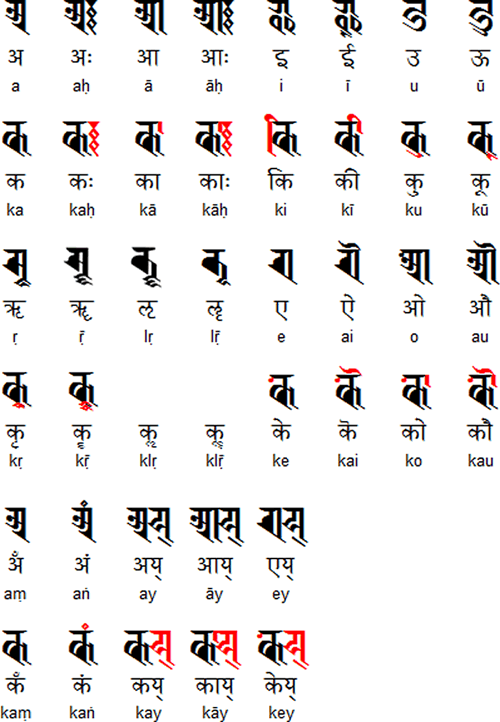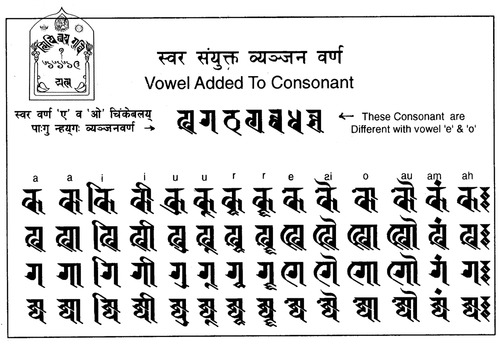Nepal Bhasa Fonts

Nepali Story, Nepali Fairy Tales, नेपाली बालकथा, Nepali Baal Katha Remember to hit the like button and subscribe for more Nepali Stories, fairy tales, and learning videos.
The Ranjana script, which is also known as Kutila or Lantsa, is one of the many alphabets derived from the Brahmi script. It developed during the 11th century AD and was used until the mid-20th century in India and Nepal by the Newari people to write the Newari language.
Tibetans use this script, which they call Lantsa, for writing the Sanskrit titles of books which have been translated from Sanskrit to Tibetan, and for decoration in temples and mandalas. There are also a few texts printed with alternating lines in Sanskrit in the Lantsa script followed by a Tibetan translation. There were many original Sanskrit manuscripts written in Lantsa preserved in the old monasteries of Tibet but most of these were destroyed following the Chinese take-over.
In addition, the Ranjana script is/was used mainly for decoration by Buddhists in China, Mongolia and Japan.
Notable features

- Type of writing system: syllabic alphabet - each letter has an inherent vowel [a]. Other vowels can be indicated using a separate letters or diacritics.
- Direction of writing: left to right in horizontal lines.
Used to write:
Nepal Bhasa (नेपाल भाषा / Newah Bhaye / Newari), a member of the Tibeto-Burman group of Sino-Tibetan languages spoken in Nepal, India, especially in Sikkim and West Bengal, and Bhutan by about 800,000 people.
As well as the Ranjana script, Nepal Bhasa has been written with the Brahmi, Gupta, Prachalit, Bhujimol and Devanagari script.
Also used to write Sanskrit, the classical language of India.
8 DStv HD Decoder Quick Guide. Installation - Connecting to the TV. Connecting the decoder to the TV. If you have a HD TV, use the supplied HDMI cable and connect it to the HDMI port (marked 1) on the back of the decoder, then connect the other end to the HDMI port on the TV. Do note that for this tutorial, we used a strong decoder (as a digital satellite signal meter) to install a DSTV satellite dish and then connected the lnbf cable to the DSTV decoder to watch all the channels available for our selected plan. How to install dstv dish and decoder pdf download. Page 12 Connecting the DStv Switch (5-1) to one DStv Explora and one to four Single View Decoders DStv Explora Use any Single View Decoder(s) one of the outputs. Once the switch has been connected to the satellite dish, use the supplied cable and connect output A or B on the switch to the input labelled UNICABLE™. To successfully connect your Explora decoder, you will need to have an 80cm satellite dish, a Smart LNB, RG6 coaxial cable, and a signal finder machine. The availability of all features of your Explora decoder depends on the quality of the installation. If you have a smart LNB, the installation is quite straight forward. Otherwise, your decoder will fail to scan the channels. When you get the signal, you have to run two RG6 cables from the smart LNB to the Explora decoder. Once the decoder picks up the signal, start scanning the channels. Read the full text of how to install the DStv Explora decoder on your own in this article.
Vowels and vowel diacritics (स्वर वण)
Consonants (व्यञ्जना वण)
Numerals (अङ्क)
Sample text (by Krozan Kapali)
Translation
Every person should be given his right and should live being as brothers and sisters.
Devanagari script for Nepal Bhasa
Sample videos in Nepal Bhasa / Newari
Onyx mac 10.15. Information about the Newari language and the Ranjana script Phrases
Links
Details of the Nepal Bhasa/Newari language and the Ranjana script
http://malaiya.tripod.com/ranjana/
http://en.wikipedia.org/wiki/Ranjana_script
http://malaiya.tripod.com/ranjana/Ranjana.pdf
Online Nepal Bhasa lessons, dictionary and other resources
http://nepalbhasa.co.cc
Online Newari dictionary
http://glosbe.com/en/new/
Online Newari phrases
http://nepaliaustralian.com/tag/learn-basic-newari/
http://wronglart.blogspot.co.uk/2013/06/newari-dictionary-some-newari-words-and.html
Newari fonts
http://www.easynepalityping.com/newari-fonts-download
Sandhya Times - online Newari newspaper
http://www.nepalnews.com.np/sandyatimes.htm
Tibeto-Burman languages
Achang, Arakanese, Balti, Bantawa, Bisu, Drung, Dzongkha, Garo, Hajong, Hani, Hmar, Jingpho, Karen, Kayah Li, Ladakhi, Lahu, Lepcha, Limbu, Lipo, Lisu, Manipuri, Marma, Mro, Naxi, Nepal Bhasa / Newari, Sikkimese, Sunuwar, Tangkhul Naga, Tibetan, Tshangla, Tujia, Yi
Languages written with the Devanāgarī alphabet
Awadhi, Bodo, Bhojpuri, Garhwali, Hindi, Jarawa, Kashmiri, Konkani, Kurukh, Magahi, Maithili, Marathi, Marwari, Mundari, Nepal Bhasa / Newari, Nepali, Pali, Rajasthani, Sanskrit, Saraiki, Shina, Sindhi, Sunuwar, Sylheti
Syllabic alphabets / abugidas
- Ahom,
- Badaga,
- Balinese,
- Batak,
- Baybayin (Tagalog),
- Bengali,
- Bilang-bilang,
- Bima,
- Blackfoot,
- Brahmi,
- Buhid,
- Burmese,
- Carrier,
- Chakma,
- Cham,
- Cree,
- Dehong Dai,
- Devanagari,
- Ditema,
- Dives Akuru,
- Ethiopic,
- Evēla Akuru,
- Fraser,
- Gondi,
- Grantha,
- Gujarati,
- Gupta,
- Gurmukhi,
- Hanifi,
- Hanuno'o,
- Inuktitut,
- Javanese,
- Jenticha,
- Kaithi,
- Kannada,
- Kawi,
- Kerinci,
- Kharosthi,
- Khmer,
- Khojki,
- Kulitan,
- Lampung,
- Lanna,
- Lao,
- Lepcha,
- Limbu,
- Lontara/Makasar,
- Lota Ende,
- Malayalam,
- Manpuri,
- Meroïtic,
- Modi,
- Mon,
- Mongolian Horizontal Square Script,
- Ojibwe,
- Odia,
- Pahawh Hmong,
- Pallava,
- Phags-pa,
- Ranjana,
- Redjang,
- Sasak,
- Satera Jontal,
- Shan,
- Sharda,
- Siddham,
- Sindhi,
- Sinhala,
- Sorang Sompeng,
- Sourashtra,
- Soyombo,
- Sundanese,
- Syloti Nagri,
- Tagbanwa,
- Takri,
- Tamil,
- Thaana,
- Telugu,
- Thai,
- Tibetan,
- Tigalari (Tulu),
- Tikamuli,
- Tocharian,
- Tolong Siki,
If you need to type in many different languages, the Q International Keyboard can help. It enables you to type almost any language that uses the Latin, Cyrillic or Greek alphabets, and is free.
If you like this site and find it useful, you can support it by making a donation via PayPal or Patreon, or by contributing in other ways. Omniglot is how I make my living.
Note: all links on this site to Amazon.com, Amazon.co.uk and Amazon.fr are affiliate links. This means I earn a commission if you click on any of them and buy something. So by clicking on these links you can help to support this site.